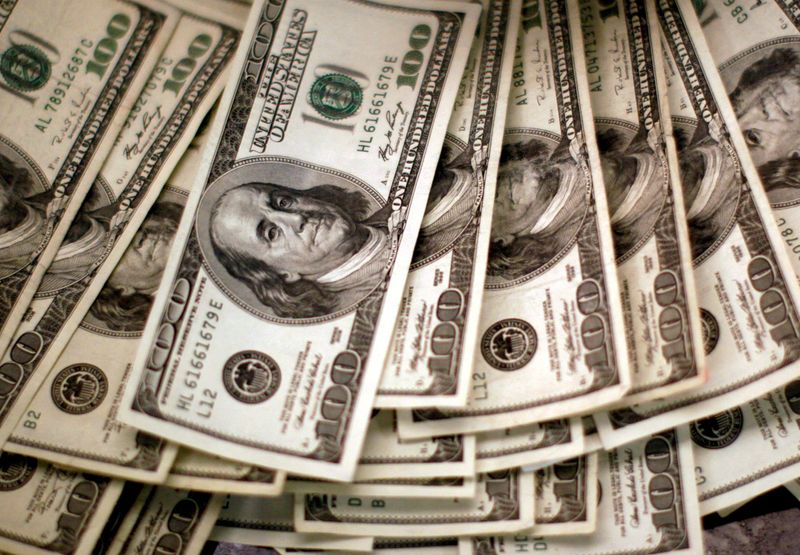Forex
Dollar slips before Fed decision, euro rises on ECB hike bets


© Reuters. FILE PHOTO: U.S. dollars are counted out by a banker counting currency at a bank in Westminster, Colorado November 3, 2009. REUTERS/Rick Wilking/
By Herbert Lash and Joice Alves
NEW YORK/LONDON (Reuters) -The dollar edged lower on Wednesday hours before the Federal Reserve is widely expected to raise interest rates in what many in the market believe will be the last of the U.S. central bank’s most aggressive rate-hiking campaign in four decades.
The announcement at 1400 ET (1800 GMT) will be followed by what is expected to be a similar hike by the European Central Bank on Thursday and the end of a Bank of Japan meeting on Friday that might shed light on its yield curve control policy.
The , a measure of the U.S. currency against six major peers, fell 0.109% but was close to an almost two-week high touched on Tuesday.
“We’ll have to see if the Fed is still not quite impressed with where inflation is. Does it still want to see more progress towards its 2% goal? That’s going to be the key,” said Joe Manimbo, senior market analyst at Convera in Washington.
Fed funds futures have priced in a 99.6% probability that the Fed hikes rates 25 basis points to a range of 5.25%-5.50% when it concludes a two-day meeting of the Federal Open Market Committee.
Market reaction will depend on Fed Chair Jerome Powell’s comments after the Fed statement is released, said Esther Reichelt, FX analyst at Commerzbank (ETR:) said.
“It is likely to be just as certain that the FX market’s reaction will not depend very much on these 25 basis points but on everything else surrounding the meeting,” she said.
A resilient U.S. economy in the face of interest rates already considered restrictive has helped lift the dollar index from a 15-month trough of 99.549 reached July 18.
FOCUS ON CENTRAL BANKS
The ECB sets policy on Thursday when a quarter point hike is widely expected, but budding evidence of an economic slowdown has called into question the chances of another by year-end.
The euro edged up 0.08% to $1.1062.
“If the ECB retain their hawkish bias, by no means guaranteed but more likely than the FOMC, euro is likely to track higher this week,” said Joseph Capurso, a strategist at Commonwealth Bank of Australia (OTC:).
Speculation about a hawkish tweak to the BoJ’s yield curve control policy led the yen to soar earlier in the month, but it has receded in recent days.
The yen strengthened 0.35% versus the greenback at 140.38 per dollar.
The Australian dollar slid 0.57% to $0.6753 after slower-than-expected inflation data suggested the Reserve Bank of Australia (RBA) would forgo a rate hike on Aug. 1.
Against the , the U.S. dollar strengthened 0.19% to 7.1511 yuan in offshore trading, retracing part of the previous day’s 0.67% decline.
Sterling edged 0.17% higher at $1.2924. The Bank of England sets rates on Aug. 3, with money markets are split between a 25 bp or a 50 bp rate hike.
Currency bid prices at 10:15 a.m. (1415 GMT)
Description RIC Last U.S. Close Pct Change YTD Pct High Bid Low Bid
Previous Change
Session
Dollar index 101.1800 101.3100 -0.11% -2.232% +101.4300 +101.0500
Euro/Dollar $1.1063 $1.1059 +0.05% +3.27% +$1.1086 +$1.1038
Dollar/Yen 140.3850 140.9700 -0.43% +7.06% +141.1800 +140.1550
Euro/Yen 155.33 155.76 -0.28% +10.71% +155.9800 +155.1600
Dollar/Swiss 0.8632 0.8641 -0.13% -6.67% +0.8656 +0.8611
Sterling/Dolla $1.2920 $1.2901 +0.16% +6.84% +$1.2926 +$1.2878
r
Dollar/Canadia 1.3206 1.3172 +0.21% -2.58% +1.3235 +1.3174
n
Aussie/Dollar $0.6752 $0.6793 -0.56% -0.91% +$0.6793 +$0.6730
Euro/Swiss 0.9551 0.9550 +0.01% -3.50% +0.9561 +0.9536
Euro/Sterling 0.8563 0.8567 -0.05% -3.18% +0.8586 +0.8562
NZ $0.6212 $0.6222 -0.10% -2.12% +$0.6233 +$0.6184
Dollar/Dollar
Dollar/Norway 10.1370 10.0690 +0.76% +3.38% +10.1560 +10.0660
Euro/Norway 11.2127 11.1206 +0.83% +6.85% +11.2401 +11.1231
Dollar/Sweden 10.4398 10.3683 +0.83% +0.31% +10.4497 +10.3403
Euro/Sweden 11.5458 11.4505 +0.83% +3.60% +11.5627 +11.4421

 Forex3 years ago
Forex3 years agoForex Today: the dollar is gaining strength amid gloomy sentiment at the start of the Fed’s week

 Forex3 years ago
Forex3 years agoUnbiased review of Pocket Option broker

 Forex3 years ago
Forex3 years agoDollar to pound sterling exchange rate today: Pound plummeted to its lowest since 1985

 Forex3 years ago
Forex3 years agoHow is the Australian dollar doing today?

 Cryptocurrency3 years ago
Cryptocurrency3 years agoWhat happened in the crypto market – current events today

 World3 years ago
World3 years agoWhy are modern video games an art form?

 Commodities3 years ago
Commodities3 years agoCopper continues to fall in price on expectations of lower demand in China

 Economy3 years ago
Economy3 years agoCrude oil tankers double in price due to EU anti-Russian sanctions


























